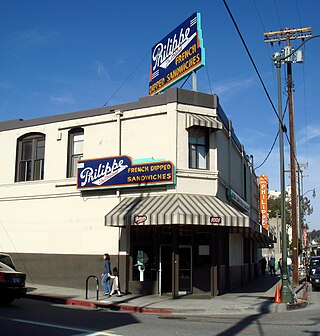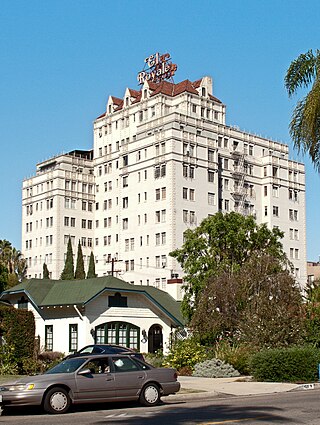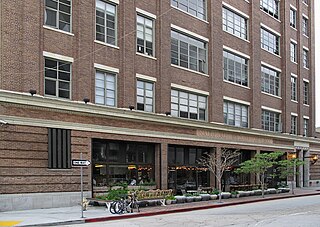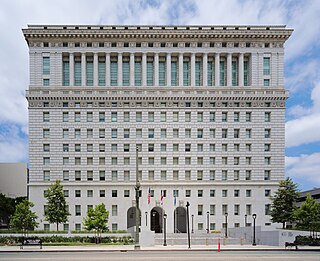
The R. J. Reynolds Tobacco Company (RJR) is an American tobacco manufacturing company based in Winston-Salem, North Carolina, and headquartered at the RJR Plaza Building. Founded by R. J. Reynolds in 1875, it is the second-largest tobacco company in the U.S.. The company is a wholly owned subsidiary of Reynolds American, after merging with the U.S. operations of British American Tobacco in 2004.

Huell Burnley Howser was an American television personality, actor, producer, writer, singer, and voice artist, best known for hosting, producing, and writing California's Gold and his human interest show Visiting... with Huell Howser, produced by KCET in Los Angeles for California PBS stations. The archive of his video chronicles offers an enhanced understanding of the history, culture, and people of California. He also voiced the Backson in Winnie the Pooh (2011).

Philippe's, or "Philippe the Original" is a restaurant located in downtown Los Angeles, California. The restaurant is well known for continuously operating since 1908, making it one of the oldest restaurants in Los Angeles. It is also renowned for claiming to be the inventor of the French dip sandwich.

Los Angeles Trade–Technical College is a public community college in Los Angeles, California. It is part of the Los Angeles Community College District and is accredited by the Accrediting Commission for Community and Junior Colleges (ACCJC), American Culinary Federation, and League of Nursing, among others.

Located in the Historic Core of Downtown Los Angeles, the Old Bank District is a group of early 20th century commercial buildings, many of which have been converted into residential (loft) use. The Old Bank District is bordered roughly by the Jewelry District, the Fashion District, Gallery Row, the Toy District, and the city's Civic Center - specifically the block from Main to Spring streets between 4th and 5th.

The Arts District is a neighborhood on the eastern edge of Downtown Los Angeles, California in the United States. The city community planning boundaries are Alameda Street on the west which blends into Little Tokyo, First Street on the north, the Los Angeles River to the east, and Violet Street on the south. Largely composed of industrial buildings dating from the early 20th century, the area has recently been revitalized, and its street scene slowly developed in the early 21st century. New art galleries have increased recognition of the area amidst the downtown, which is known for its art museums.

The Eastern Columbia Building, also known as the Eastern Columbia Lofts, is a thirteen-story Art Deco building designed by Claud Beelman located at 849 S. Broadway in the Broadway Theater District of Downtown Los Angeles. It opened on September 12, 1930, after just nine months of construction. It was built at a cost of $1.25 million as the new headquarters and 39th store for the Eastern-Columbia Department Store, whose component Eastern and Columbia stores were founded by Adolph Sieroty and family. At the time of construction, the City of Los Angeles enforced a height limit of 150 feet (46 m), however the decorative clock tower was granted an exemption, allowing the clock a total height of 264 feet (80 m). J. V. McNeil Company was the general contractor.

The historic Subway Terminal, now Metro 417, opened in 1925 at 417 South Hill Street near Pershing Square, in the core of Los Angeles as the second, main train station of the Pacific Electric Railway; it served passengers boarding trains for the west and north of Southern California through a mile-long shortcut under Bunker Hill popularly called the "Hollywood Subway," but officially known as the Belmont Tunnel. The station served alongside the Pacific Electric Building at 6th & Main, which opened in 1905 to serve lines to the south and east. The Subway Terminal was designed by Schultze and Weaver in an Italian Renaissance Revival style, and the station itself lay underground below offices of the upper floors, since repurposed into the Metro 417 luxury apartments. When the underground Red Line was built, the new Pershing Square station was cut north under Hill Street alongside the Terminal building, divided from the Subway’s east end by just a retaining wall. At its peak in the 20th century, the Subway Terminal served upwards of 20 million passengers a year.

The Hollywood Subway, as it is most commonly known, officially the Belmont Tunnel, was a subway tunnel used by the interurban streetcars of the Pacific Electric Railway. It ran from its northwest entrance in today's Westlake district to the Subway Terminal Building, in the Historic Core, the business and commercial center of Los Angeles from around the 1910s through the 1950s. The Subway Terminal was one of the Pacific Electric Railway’s two main hubs, the other being the Pacific Electric Building at 6th and Main. Numerous lines proceeded from the San Fernando Valley, Glendale, Santa Monica and Hollywood into the tunnel in Westlake and traveled southeast under Crown and Bunker Hill towards the Subway Terminal.

The Federal Reserve Bank of San Francisco, Los Angeles Branch, is the Southern California branch of the Federal Reserve Bank of San Francisco, located on West Olympic Boulevard and South Olive Street in southern Downtown Los Angeles. It is within the Twelfth Federal Reserve District.

The Century is a 42-story, 146.5 m (481 ft) condominium skyscraper in Century City, California. Completed in late 2009, the building has 42 floors, making it the 22nd tallest building in Los Angeles. The 140 unit building was designed by the firm of the 2011 Driehaus Prize winner, Robert A.M. Stern Architects.

Clifton's Cafeteria, once part of a chain of eight Clifton's restaurants, was the oldest surviving cafeteria-style eatery in Los Angeles and the largest public cafeteria in the world when it closed in 2018. Founded in 1931 by Clifford Clinton, the design of the restaurants included exotic decor and facades that were "kitschy and theatrical", and would eventually include multi-story fake redwood trees, stuffed lions, neon plants, and a petrified wood bar. Some considered Clifton's as a precursor to the first tiki bars. The name was created by combining "Clifford" and "Clinton" to produce "Clifton's".

Pershing Square is a small public park in Downtown Los Angeles, California, one square block in size, bounded by 5th Street to the north, 6th Street to the south, Hill Street to the east, and Olive Street to the west. Originally dedicated in 1866 by Mayor Cristóbal Aguilar as La Plaza Abaja, the square has had numerous names over the years until it was finally dedicated in honor of General John J. Pershing in 1918.

The El Royale is a historic apartment complex located at the intersection of Rosewood Avenue and Rossmore Avenue in the Hancock Park neighborhood of Los Angeles. It was designed by famed architect William Douglas Lee and completed in 1929.

The Pig 'n Whistle was an American restaurant and bar located in Hollywood on Hollywood Boulevard.

Leonard Franklin Hill was an American television producer and property developer. Hill began his career as a television writer, writing scripts for numerous shows, including Adam-12, an NBC police drama. He then became a television executive, serving first at NBC before becoming Vice President of Movies at ABC. Hill produced four television miniseries, dozens of television movies and three drama series during his tenures at NBC and ABC. His television movies were mostly distributed by Pearson Television, who was once successor of ACI.

The Saban Building, formerly the May Company Building, on Wilshire Boulevard in the Miracle Mile district of Los Angeles, is a celebrated example of Streamline Moderne architecture. The building's architect Albert C. Martin, Sr., also designed the Million Dollar Theater and Los Angeles City Hall. The May Company Building is a Los Angeles Historic-Cultural Monument. The building was operated as a May Company department store from 1939 until the store's closure in 1992, when May merged with J. W. Robinson's to form Robinsons-May. The building has been the home of the Academy Museum of Motion Pictures since 2021.

The Broadway Hollywood Building is a building in Los Angeles' Hollywood district. The building is situated in the Hollywood Walk of Fame monument area on the southwest corner of the intersection referred to as Hollywood and Vine, marking the intersection of Hollywood Boulevard and Vine Street. It was originally built as the B. H. Dyas Building in 1927. The Broadway Hollywood Building is referred to by both its main address of 6300 Hollywood Boulevard and its side address of 1645 Vine Street.

The St. Vincent's Place is the second location of Saint Vincent College in Central Los Angeles, California. St. Vincent's Place was designated a California Historic Landmark (No.567) on Feb. 25, 1957. St. Vincent's College was started by Vincentian Fathers in 1865 and was the first College in Southern California. St. Vincent's Place is located at St. Vincent Court at 7th Street and Broadway in the City of Los Angeles in Los Angeles County. St. Vincent's College became L.A. College in 1911 and Loyola Marymount University in 1917. Saint Vincent's College used the Downtown Los Angeles site from 1868 to 1887. Broadway was called Fort Street in 1868. St. Vincent's Court is now a small alley running through the center of the former Bullock's complex, this was the main entrance to St. Vincent’s College in 1868, a keen city promoter remodeled it as a imitation of a European village square.

The Hall of Justice in Los Angeles is located at 211 W. Temple Street in the Civic Center district of Downtown Los Angeles. It occupies the southern two-thirds of the block between Temple and First streets and between Broadway and Spring streets.





















